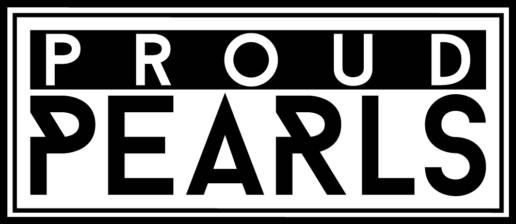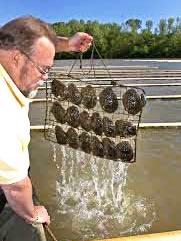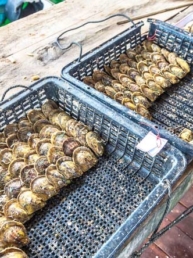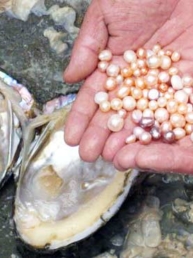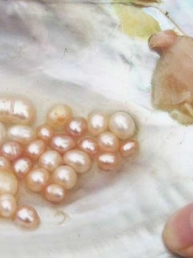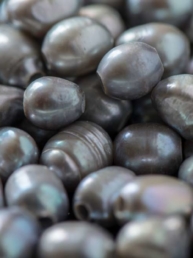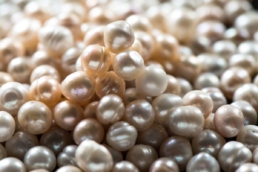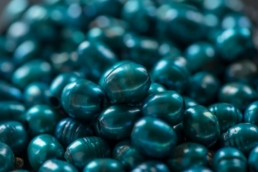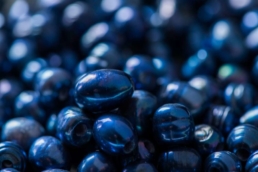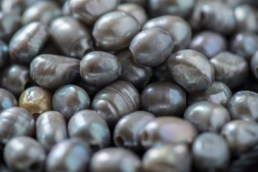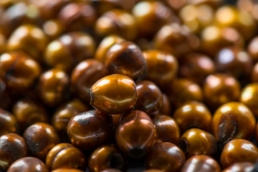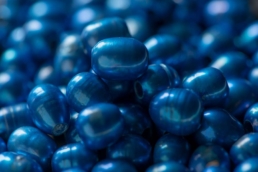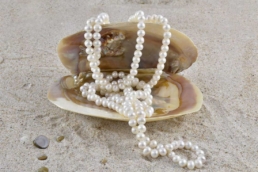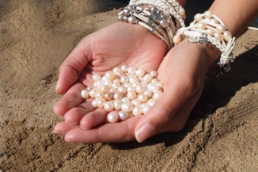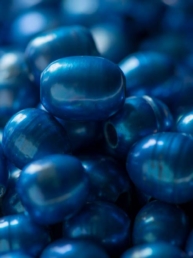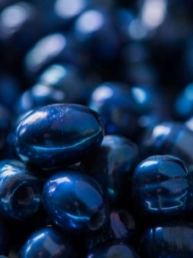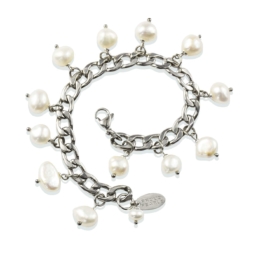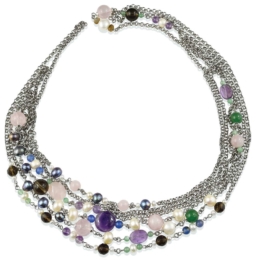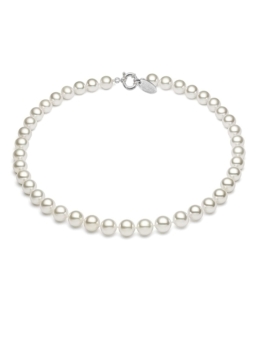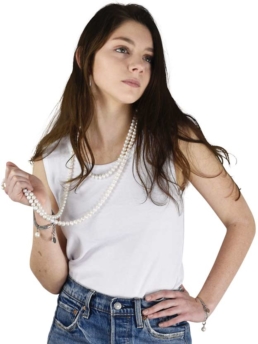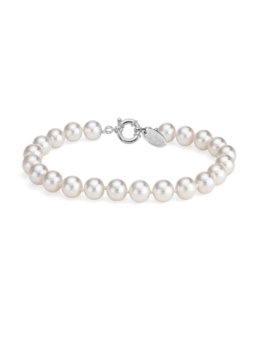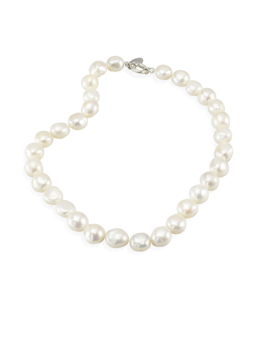The pearl farm
Mikimoto
The Japanese Kokichi Mikimoto discovered in 1896 when you put a piece of tissue in a mussel or oyster, it creates a pearl: it creates an irritation which ensures that many layers of pearl are formed around the piece of tissue, ultimately creating pearls we know and love. Mikimoto has worked for many years on a method to grow the perfect pearl. He experimented with different types of mussels and oysters until he finally succeeded. Known as “the king of pearls”, the Mikimoto brand has grown into an exclusive pearl jewellery brand that is highly regarded to this day.

Kokichi Mikimoto in his laboratory
Pearl farms
Pearls are formed in mussels (freshwater pearls) or oysters (sea pearls). Since it is no longer legal to source pearls from the wild, all available pearls are grown by pearl farms. A pearl farm is a lake in which the mussels and oysters grow.
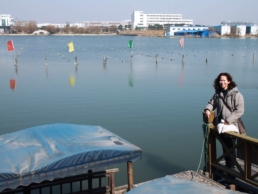
We visit “our” pearl farm every year to ensure that our pearls are of the highest quality.
Circa 1920, the production of cultured pearls started on a large scale and to this day is the method used to grow pearls. The oysters and mussels are “operated on” and a core is implanted. This job requires delicate care because the animal has to survive this procedure. Freshwater pearl mussels are very strong and can grow up to 30 pearls at a time. The saltwater pearl oysters are much more sensitive and only produce one pearl per cycle. The oysters and mussels are clamped between grates and hung in the water in the lakes of the pearl farm.
The cultivation of pearls takes time since the mussels or oysters need to mature. This will take about three years. Then the pearl must grow, this takes at least three years and it can take up to seven years before a sufficiently thick layer of mother-of-pearl is created and a beautiful pearl of high quality is created.
The harvest
The pearls are rinsed and then sorted by colour, size, shape and quality. With rarer pearl types, it can sometimes take a few years before there are enough similar pearls to be able to make a pearl necklace. The sorting process is very precise and is done by specialists.
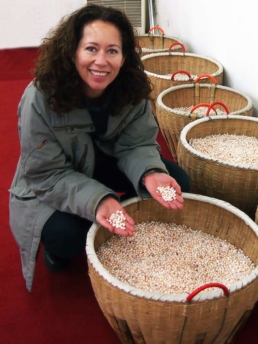
We selecteren zelf de mooiste parels voor in onze collecties
A fair trial
During the breeding season, the shells are cleaned regularly, the algae, parasites and other deposits are carefully removed. The water temperature and the quality of the water are carefully monitored by the growers. Pearl farmers are therefore very conscious of the environment and do everything they can to keep the water in which they grow their pearls as pure as possible. This makes the cultivation of pearls more sustainable than the production of any other gemstone.
Sustainability
The pearl cultivation can be done with minimal waste: the mussels and oysters used for pearl cultivation are not thrown away since they can last for multiple cycles. The shells are then ground and used for road construction, for example, and the meat is used for animal feed and fertiliser. Pearls are the only organic jewellery made by nature itself. The cultivation of pearls has sustainable and social effects on the environment making it a particularly sustainable industry. Mussels and oysters need clean, unpolluted water to produce high-quality pearls. We work with small certified pearl farms which we visit ourselves every year so we can process the most beautiful pearls in our collections.
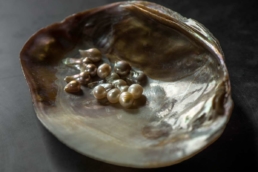
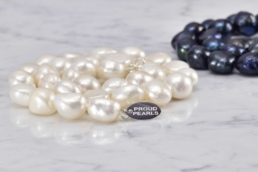


Bron: https://nl.wikipedia.org
How to recognise real pearls
How to recognise real pearls
Proud Pearls guarantees that all of the pearls used in our pieces are real, but how can you tell whether they are real or fake on your own…
Some simple tests can help you determine whether your pearls are real or not. If you have any doubts about the authenticity of the pearls you have in your possession, you can always have them tested by us.
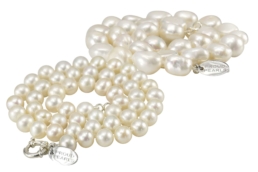
On the is left an example of the highest quality AAA pearls, these are round pearls. On the right is an example of Baroque pearls, also commonly referred to as “wild” pearls. Read more about the different types of pearls in our other blog posts.
1: Look for minor imperfections:
Real pearls are rarely “perfect”. Real pearls usually have minor imperfections or irregularities in their shape. The outer layer of mother-of-pearl can reflect the light differently on different parts of the pearl. Imitation pearls are almost always too perfect, they appear perfectly round, they have an even shine throughout, and have no dents or other flaws. Even though there are perfectly round pearls, they are very rare and a necklace seldom consists entirely of this type of pearls. A necklace made of pearls that all appear to have the same smooth, round shape is almost certainly a fake.
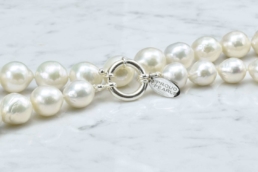
2: Examine whether the pearls have a sharp, healthy shine:
“Lustre” or shine is a term used by jewellers to describe the type of light being reflected from a pearl. The shine is one of the things that makes a pearl so beautiful; good quality pearls have a bright and clear lustre that makes them sparkle when light shines on them.
Pearls come in all shapes and colours: freshwater pearls can be white or pastels such as lilac, cream, or pink. Pearls can also be dyed to other colours, you can read more about this process in our other blog posts about the different types of pearls.
3: Look at the overtone:
High-quality pearls are often valued for their overtone, which is the subtle colour that shows on the surface when light hits them. Imitation pearls tend to not have this effect because this overtone is hard to emulate. As such, if you notice that your pearls have a bit of a different colour when light falls on them, chances are that your pearl is real. Pink and ivory are two of the most sought after overtones for white pearls, but many different colours are possible.
4: Look for clues near the borehole:
Pearls that are part of a strand or necklace usually have drill holes for the cord to pass through. Studying these holes carefully can help you find out if the pearl is real or not. Pay attention to the following things:
A drill hole with clear edges. Real pearls usually have sharp-edged boreholes (like a hollow cylinder). Imitation pearls often have rough or rounded edges. However, older, more worn real pearls can also have boreholes with rounded edges. Drill holes in imitation pearls can also bend outward on the surface of the pearl, instead of being perfectly cylindrical.
Chipped paint or varnish around the hole. Imitation pearls rub against each other when you wear them often and the imitation varnish around the holes can therefore wear away. You may see splinters of glass or plastic under the paint. This is a clear sign that the pearl is not real.
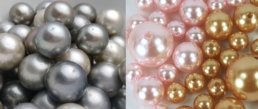
The pearls to the left are a good example of precious Akoya (sea pearls), the pearls on the right are a good example of “perfect” fake pearls.
5: Look in the Drill hole to see if you can see a line between the mother-of-pearl and the core:
Pay attention to the following: a real pearl almost always has a clear outer layer of mother-of-pearl, while imitation pearls have thin layers of imitation mother-of-pearl or none at all. If your pearl has a borehole, you can use a magnifying glass to see if it has a layer of mother-of-pearl. Real pearls usually (but not always) have a clearly visible stripe that separates the mother-of-pearl from the core (the inner part of the pearl).
6: Rub the pearls against your front teeth:
Hold one or two pearls between your thumb and forefinger and gently push them against the cutting edge of your front teeth. Rub them along your teeth in a sideways motion. A real pearl usually has a slightly rough or grainy texture caused by tiny, flaky blemishes in the outer layers of the pearl. Imitation pearls of glass or plastic are usually almost perfectly smooth.

Sea pearls grow in oysters, freshwater pearls grow in large mussels, above is an example of freshwater pearls, read more in our blog about pearl cultivation.
7: Rub the pearls together:
Hold a few pearls between your fingers and gently rub them together. See if you feel a slight friction. Rubbing real pearls together will usually create some friction because the outer layers of the mother-of-pearl are not perfectly smooth. Imitation pearls, on the other hand, often have a smooth finish and will therefore slide past each other when you rub them together.
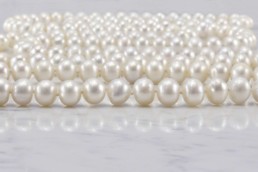
In the photo an example of the beautiful round AAA quality pearls that we use in our collections.
8: Check if the pearls are not “too perfectly” round:
Since pearls are natural products, every real pearl is slightly different, just like snowflakes or fingerprints. Most pearls will not be perfectly round, they are usually a bit oval or have minor flaws. If your pearls look perfectly round, chances are they are imitation pearls. However, real pearls can be perfectly round, these pearls are very rare and therefore very expensive. Perfectly round pearls are referred to as AAA pearls, we also use them in our collections, but these pieces are a lot more expensive than jewellery with baroque pearls.
9: See if the pearls feel cool:
For this test, you will need some pearls that you have left somewhere for a long time – not pearls that you have worn. Hold the pearls in your hand and pay close attention to how they feel. Real pearls will feel remarkably cool for a few seconds before heating up. It feels similar to stepping on a marble floor with bare feet. Plastic pearls, on the other hand, will be about room temperature and will also heat up faster. Please note, good quality glass imitation pearls can still feel “cool”. If this is the first test you’ve tried, run more tests to see if your results are correct.
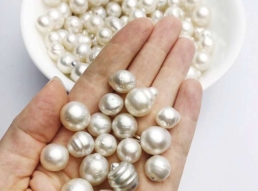
10: See how heavy the pearl feels in your hand:
Gently bounce one or two pearls into your hand to get an idea of how heavy they are. Most real pearls feel a little too heavy for their size. However, imitation pearls (especially plastic ones) will feel light and hollow. Obviously, this test is not perfect, it can be difficult to determine the weight of a few small pearls. For the best result, it is best to compare your pearls with pearls that you are sure are real or fake. Always check the results by running another test, no matter how confident you are of the weight of a pearl.

Fake pearls production: glass beads are dipped in a “mother-of-pearl” solution.
Majorica pearls and other fake pearls
Running in a completely different direction, Majorica pearls, sold in red boxes, are artificially made pearls in a factory. These pearls are made of glass balls that are immersed in a solution made of, among other things, fish scales. The layer on the glass is usually thin and can wear off over time. On the island of Mallorca, many of these pearls are falsely sold as real pearls. These tend to be targeted towards tourists. In addition to factory pearls made from fish scales, there are also shell pearls, which are made by sawing blocks from thick shells and grinding and polishing them. You can recognise a cord with shell pearls because all pearls have the same shape and are perfectly round. There are also plastic pearls and glass pearls on the market, of course, these have nothing to do with natural or cultured pearls.
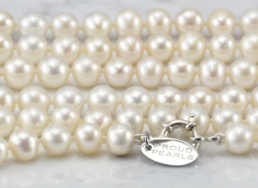
We give a 100% guarantee that all of the pearls in our collections are real, if you have any doubts about the authenticity of other pearls that you have in your possession, you can always have them tested by us.



Bron: https://nl.wikipedia.org
Pearls and the different types
Natural and Cultured
Pearls can be divided into two groups. Natural pearls and cultured pearls. Often people are mistaken and think that cultured pearls are not “real” pearls. The difference between natural and cultured pearls is that natural pearls, as the name implies, are found in nature. Cultured pearls are cultivated in large waters in mussels and in oysters by pearl farmers.

Cultivated freshwater pearls in a mussel
Ecologically sound
The advantage of cultured pearls is that the people influence the environment in which the shells live. This allows the pearls to be of higher quality and to be more beautiful. In nature, it is difficult to find a high-quality pearl. When these are found, they are extremely expensive (think of sheiks and royal houses). Another reason that more cultured pearls are sold is that the extraction of natural pearls is not ecologically sound. Growing pearls can be ecologically sound, you can read more about this and about the growth of pearls in our blog “The Pearl farm”.
Another distinction is between saltwater pearls and freshwater pearls. Both can be found in nature and on farms. A fun fact, saltwater pearls are created in oysters and freshwater pearls in mussels.

Most pearls that are currently for sale in the world are grown at special pearl nurseries, these pearls are called cultured pearls. There are four main types of pearls that have been farmed. These are Akoya pearls, Tahiti pearls, South Sea pearls and freshwater pearls. The first three are sea pearls, the pearls in our collections are freshwater pearls.
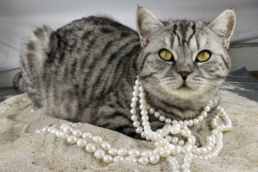
Beertje, our studio cat, with a necklace made of round and baroque pearls.
Difference in shape
We are often asked what types of pearls are used in our collections and how you can recognise them. Everyone knows the round pearl as seen in a classic pearl necklace, think of Queen Elizabeth’s necklace and the pearls you probably saw your grandmother wearing on special occasions. The pearls in our collections include round pearls, baroque pearls and potato pearls, from small 2/3mm to large 12/14mm.

Ronde AAA-kwaliteit parels, herkenbaar aan de mooie ronde vorm en mooie glans.
Round pearls
Within the round pearls,k there is a huge difference in value, this is determined by the size, how perfectly round the pearl is and what kind of shine it has. Round pearls that are almost perfectly round and have the most beautiful shine are indicated by AAA quality. Round pearls are much rarer than all other shaped pearls, we have both very small AAA pearls (4-5mm) in our collection as well as very large round pearls (10-12mm).
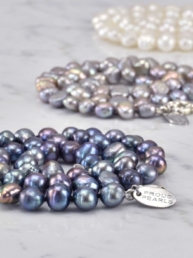

Small and large baroque pearls, capricious and unpredictable in shape.
Baroque pearls
Baroque pearls are pearls of irregular shape. This irregular shape varies from small deviations to large, irregular, natural shapes. This pearl is often incorrectly referred to as a “wild” pearl, although the shape may appear “wild”, these pearls are also cultured. We love this surprising pearl and you will see it in our designs from very small (4 / 5mm) to very large (12 / 14mm).
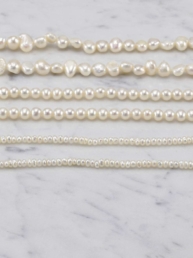
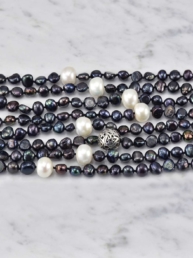
On the left photo from top to bottom: baroque, round and potato pearls. On the right photo a combination of black baroque pearls with large round potato pearls.
Rice and Potato pearls
Rice pearls are elongated pearls and look a bit like a grain of rice, hence its name. The potato pearl has a round to oval shape and looks a bit like a potato. Both pearls come in different sizes and are used by us in both a small size and a very large size.
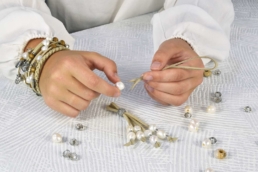
In the workshops we give, we work with beautiful baroque pearls, just like in our DIY packages.
Other pearls
In addition to the pearls mentioned above, there are many more pearls such as the nugget pearl (flat at the bottom and convex on the other side), coin pearls (shape of a coin), the Keshi pearl (poppy seed pearls) and many more. Perhaps in the near future we will dedicate a new blog to the many names of pearls.
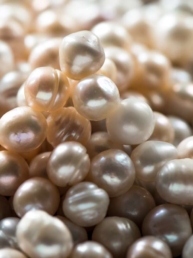
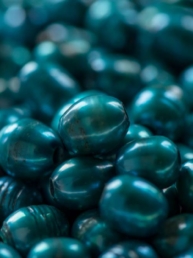
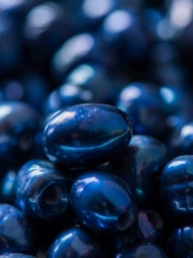
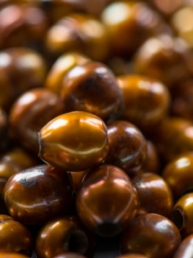
In the first photo, an example of the natural colour of freshwater pearls, in the other photos examples of coloured pearls.
Coloured pearls
The natural colour of freshwater pearls is white, salmon, light pink and other light pastels. In addition, it is possible to obtain pearls in all possible colours. The colouring of freshwater pearls is done in two ways:
1- The first way is dyeing, pearls are treated with silver nitrate which is so strong that it penetrates into the pearlescent layers. Sometimes different dyes are used. Dyed pearls often have a higher concentration of colour around the borehole.
2- The second way of colouring pearls is by using y-rays or gamma rays. This is an invisible electromagnetic radiation. The result is a darkening of the outer layer of the pearl and a black-blue metallic sheen.
Coloured pearls retain their value and are therefore worth no less because of the treatment they have undergone.


Pearls and caring for them
Be careful with your hygiene and cosmetic products
Personal care products can damage pearls. Cosmetics, sunscreens, perfumes and hairspray contain chemicals that can affect the shine of a pearl. The natural acids in body oils and perspiration can damage pearls in the same way. A good rule of thumb is: put the pearls on last and take them off first.

Protecting pearls
After wearing your pearls, you can clean them with a damp, soft cloth to remove the harmful substances that can affect the mother-of-pearl. Always keep the pearls separate from other hard jewellery such as rings or bracelets to prevent them from being scratched.
Pearls are best kept in a soft cloth bag or in a soft lined jewellery box. Never store pearls in an airtight environment such as a zip lock bag. Pearls are organic and contain traces of water. Storing them in an airtight environment will make them brittle and might damage the shine.
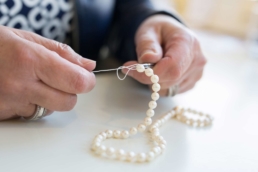
Re-stringing your pearls
If pearls are worn frequently, they should be re-strung about once a year to keep the strand from breaking. Pearl knotting is a real craft, the thread must be knotted between each pearl to prevent all the pearls from falling off the strand in case of a break. The knots also prevent damage because the pearls cannot rub against each other.
You can have your pearls knotted again at a jeweller who usually charges a fixed amount per knot, plus the costs for attaching the closure, you can easily assume an amount of at least €50. We offer a cheaper alternative for our regular customers: our experienced knotter Nelly (60 years of experience) can knot the pearls again for you, please contact us for more information.
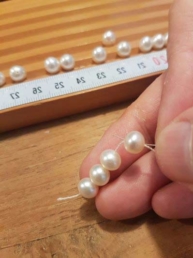
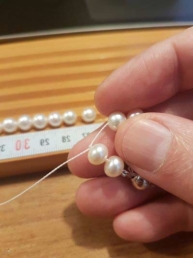
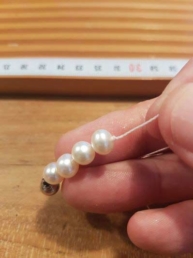
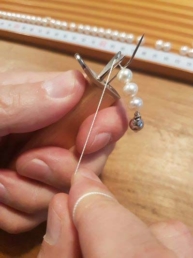




Bron: https://nl.wikipedia.org
